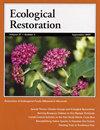火灾和冰的试验:美国俄亥俄州西南部草原卡氏锥入侵控制技术评估
IF 1.1
4区 环境科学与生态学
Q2 ECOLOGY
引用次数: 0
摘要
摘要梨是一种入侵性植物,威胁着美国东部的生态系统。我们研究了不同防治技术对草原卡氏疟原虫入侵的效果。对(a)P.calleyana茎进行了处理,这些茎每年修剪几年,正在发芽(n=100个茎;“树木发芽”),以及(b)大约10年前建立的茎,从未被切割过,是单茎树(n=40个茎,“树木完好无损”)。在这两个实验中,对现有的茎进行切割,并随机分配以下处理之一:仅切割(对照)、燃烧、冷冻或除草剂,在树木发芽实验中,也有监测现有芽的阴性对照。所有用除草剂处理树桩的树木都被有效地杀死了,而在两个实验中,所有其他处理的树干都产生了强烈的发芽反应。在树木发芽实验中,处理的总体效果很强(RMANOVA;p<0.001),与阴性对照相比,规定的火苗使发芽数量在统计学上显著增加(事后检验;p=0.036)。在树木完整实验中,除除草剂外,所有处理都能使树木发芽旺盛。树桩冷冻导致发芽反应延迟;然而,所有冷冻的茎最终都发芽了。即使在经历了频繁而强烈的生态干扰后,该物种仍能旺盛地发芽,这为该物种所在栖息地的旧田地演替带来了根本性改变的可能性。本文章由计算机程序翻译,如有差异,请以英文原文为准。
A Trial of Fire and Ice: Assessment of Control Techniques for Pyrus calleryana Invasion of Grasslands in Southwestern Ohio, USA
ABSTRACT Pyrus calleryana (Callery pear) is an invasive plant that threatens ecosystems in the eastern United States. We investigated the efficacy of various control techniques on P. calleryana invasion in grasslands. Treatments were applied to (a) P. calleryana stems that had experienced mowing annually for several years and were sprouting (n = 100 stems; “trees-sprouting”) and (b) stems that had established ca. 10 years earlier, had never been cut, and were single-stemmed trees (n = 40 stems; “trees-intact”). In both experiments, existing stems were cut and randomly assigned one of the following treatments: cut only (control), burning, freezing, or herbicide, and in the trees-sprouting experiment there was also a negative control of monitoring existing sprouts. All trees in which the cut stumps were treated with herbicide were effectively killed, whereas stems in all other treatments, in both experiments, generated a vigorous sprout response. In the trees-sprouting experiment, there was a strong overall effect of treatments (RMANOVA; p < 0.001) and prescribed fire created a statistically significant increase in sprout number in relationship to the negative control (post-hoc test; p = 0.036). In the trees-intact experiment, there was vigorous sprouting in response to all treatments other than herbicide. Stump freezing resulted in a delay in sprout response; however, all frozen stems eventually sprouted. The ability of this species to sprout vigorously, even after experiencing frequent and intense ecological disturbance, creates the potential for a fundamental alteration of old-field succession in habitats where this species is present.
求助全文
通过发布文献求助,成功后即可免费获取论文全文。
去求助
来源期刊

Ecological Restoration
Environmental Science-Nature and Landscape Conservation
CiteScore
1.70
自引率
12.50%
发文量
24
期刊介绍:
Ecological Restoration is a forum for people advancing the science and practice of restoration ecology. It features the technical and biological aspects of restoring landscapes, as well as collaborations between restorationists and the design professions, land-use policy, the role of education, and more. This quarterly publication includes peer-reviewed science articles, perspectives and notes, book reviews, abstracts of restoration ecology progress published elsewhere, and announcements of scientific and professional meetings.
 求助内容:
求助内容: 应助结果提醒方式:
应助结果提醒方式:


